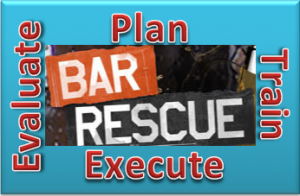 Reality TV comes in all sizes and shapes, from cramming a bunch a young “adults” into a house or on an island and seeing what happens when assigned “challenges” to helping a business get back on track. Everyone has a favorite and mine is Bar Rescue.
Reality TV comes in all sizes and shapes, from cramming a bunch a young “adults” into a house or on an island and seeing what happens when assigned “challenges” to helping a business get back on track. Everyone has a favorite and mine is Bar Rescue.
I’ll admit that I know nothing about running a bar, and the initial draw for me was the expert’s name: Jon Taffer. Like most shows of this type, each episode follows the same pattern: evaluate, plan, train, execute.
In the Evaluate stage, the team of experts observe the bar employees at work and assess their skill levels.
In the Plan stage, the team of experts and the bar owner review the evaluation and develop a plan to improve the bar. All aspects are considered: the surrounding neighborhood, the bar exterior and interior, drinks, food menu, and staff skill levels.
In the Train stage, an expert works with the bartenders to train them in how to make a collection of signature drinks for this bar and how to pour exact ounce portions. Overpouring is the single biggest flaw in the industry. The expert chef works with the kitchen staff to develop a few signature dishes for the bar. Having too many options on the menu is a money pit since storing all the ingredients for many dishes is costly and wasteful if the stored food spoils. Plus the small kitchen staff in a bar has issues switching back and forth among menu choices and it slows down the delivery order times.
In Execute, all of the pieces come together: the new drink and food menu, the building renovations, the trained employees, and the owner’s new understanding of how a bar should be run.
What impresses me most in a Bar Rescue episode is the Training. If the staff isn’t trained properly, the whole rescue can fail. When properly trained, the staff members take on a new personality. They are confident and happy doing the job. Their stress level decreases even though the bar patrons double. The whole staff is proud of the drinks and food served.
When we implement the Spitfire Project Management System with a new client, we follow the same pattern: Evaluate, Plan, Train, and Execute. Unfortunately, we aren’t a television series and our clients do not have unlimited funds, so the Training of the staff is usually handled by the client. During implementation, we train the client’s Trainer and help with “client-specific” documentation. But all the time spent on Evaluation and Planning doesn’t bear fruit if the end users aren’t trained properly. Spitfire is a web application, but no one should assume that all web applications are alike. Just because users shop at Amazon.com or have a Facebook account doesn’t mean they are trained for all web applications.
A properly trained end user will be more efficient, less stressed, and focused on the project (instead of “how am I going to get this picture into Spitfire?”). Since Spitfire adds new features in every upgrade and businesses don’t stand still (with added staff or turnover or changed business models, etc.), our clients are wise to go through the Evaluate, Plan, Train and Execute process again and again to ensure they are getting the most for their dollar.
Are you going through the Evaluate, Plan, Train and Execute process on your system, or are you due for a review?
Tweet